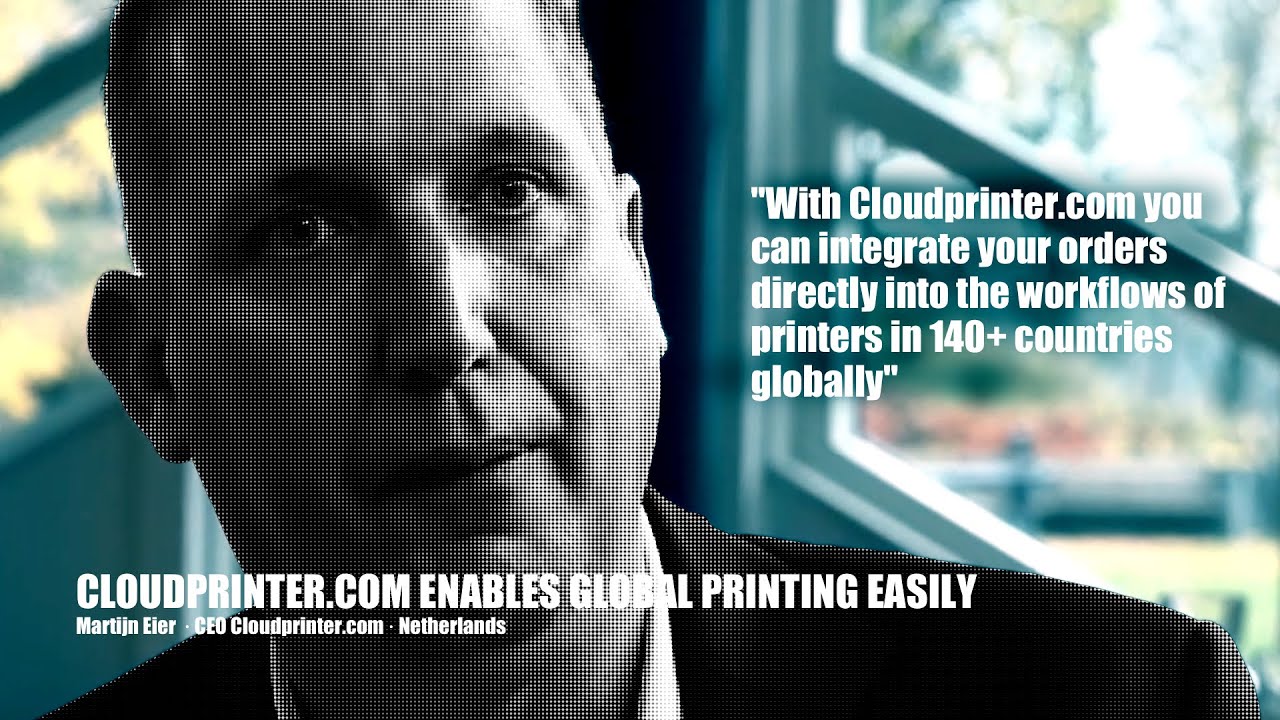Cloudprinter.com enables global printing easily · Martijn Eier · CEO Cloudprinter · Netherlands
Cloudprinter.com enables their customers to integrate print-services into their IT which in return enables them to deliver in 140+ countries. The “secret” is the set of API’s offered by cloudprinter.com that route the jobs to the printer able to deliver where the product is needed. cloudprinter integrates directly into the printer’s workflow and therefore is an advantage for both buyers and sellers. But listen to this interview yourself and get much wiser.
As usual, please watch, like, and share!
Well we hope so. I think we bring together the print buyer and the print service providers on very automated way which is quite regular in the Internet industry using API’s, so it’s not a revolution, it’s not just two different sectors you bring together.
So we provide a global print API for local printing. And an API is a kind of interface used to connect different programming languages in quite easy way, used every day. For example, you post something to Facebook from a news site that’s probably integrated by APIs and we enable print buyers who are running an E-commerce or a web-to-print platform to connect to our API to print locally in almost any country in the world.
You start a dot com and then you try to find local print partners which can take months and to integrate them one-by-one and that’s where our solution comes in. So you connect, one integration and you are directly connected to local print partners in each market.
Yeah, it starts already with storing the data. Some of our American customers require that we don’t store it in the cloud on servers that are based in, let’s say, Europe or in Asia. They want to have an Amazon web platform hosted in the US and that’s why we have five or six different cloud instances around the world, to always fulfill with the local regulation. The same you have with printed products, certain countries require with canvas that it’s not printed on certain material.
It came more as a practical result of the challenges we were experiencing every day at previous jobs, my co-founder Mogens and I were dealing with sourcing print jobs every day around the world. You met a new printer, you integrate them, some of them went bankrupt, some of them had a problem during peak season, others had issues with capacity or a broken machine. And we learned that it was not really one way of submitting print jobs and reroute them or load balance in between different print partners. So we thought we should come with a solution for that.
I’ve a background in printing, as well as background in working at publishing companies so I know it from both sides.
That’s correct. We work publishers who, before, were shipping their sales for an Amazon or an online book store from the UK to any country in Europe, and that didn’t make them competitive because the shipping rates were too high, transit times too long. Now when they get an order for a certain educational book from Dubai, then it’s printed a few hours later in Dubai and the customer will have it the next day against local shipping tariffs.
When we integrate with a printer, it always takes some time to make clear that we reward full automation. So if a printer really understand that they need to have a proper workflow and that they need to have automated order handling, then we reward them with bringing new volume to them. So we are not an enemy, it’s just one integration that brings you a lot of new customers as long you’re willing to automate. Because we require that automation because the print buyer requires that. They want to know when a product is printed and not because they like to track the order, no, they want to connect those signals of a printed product et cetera, to internet solutions like a MailChimp or an HubSpot to inform their customers in an automated way.
Well, there are a lot of downsides, because before certain publishers or print buyers, they were bundling all their volume to a specific print partner in each region to get a proper low price, and that is a system we disrupt, we go against the regular economic model of sourcing as much as possible volume to print partner. We spread it more equally so it’s quite democratic, to say it like that.
So let’s assume that you are a small web print provider from the US and you have a business card order for Singapore. You will pay the same for that job as our largest customer, because we charge the pricing one-on-one to our customers without any margin.
Our business model is that we charge our customers, the print buyer, a softwares and service fee which range from 99 to 5000 Euro a month and for that fee they get a virtual global network which they can manage themselves, either by API calls or by creating routing profiles in our dashboard.
It’s more like how many influence you like to have on your routing. So if you just rely on our algorithm, you can already use our service from 99 Euro a month. But if you want to have, let’s say, a more dedicated or you want to have custom pricing or custom products, then we go up to a bit higher subscriptions.
We offer 420 predefined product templates with all the related finishing options, et cetera. But if you like to have a product that’s specifically for you, not a product that we might activate and offer to all our customers as well, then you come to the bit higher subscriptions. It’s more custom-made. And then we also do custom routing, custom profiles. We have customers who say, “We like to have a feature that if an order comes in before 3 pm, it goes to printer A. After 3 pm it should go to printer B, which might be more expensive, but he can still ship it the same day.” And that is what we call enterprise solution on our site.
Yeah, we have just one API, but the routing and all those kinds of things you can set in our dashboard. You just drag and drop to create a routing rules or profiles.
We were establishing Cloud Print three years ago, but we went commercially live only August a year ago. So, just more than a year. What we like to be is like you use a Gmail or Gdrive for your documents, we like to be the API for printing online. It’s the beginning.
Well, there are a lot of APIs available to submit your orders, but they are often kind of vendor lock-in so they are related to a certain print group or to a vendor. There are solutions from HP, there are solutions from a group of print houses working together, but we are the independent one. Which means we can route to an HP, to an Xerox. We can route to parties who offer an API but then the next day to another one. So we are really independent.
We call it always the chicken and the egg. On the moment you don’t have a print partner. You don’t have a proper volume in a country because our customers will start to sell actively products for that market when they have local shipping rates. So it’s often the chicken and the egg, but that takes just a few weeks. So our experience is that connecting a new print partner, after two, three weeks they are on a serious volume and the definition of serious depending on the market, but let’s say from 200 jobs a day, that’s kind of a minimum that we expect a source.
When we started, we thought about teaming up with solutions from the vendors, and then we learned we should work together with a workflow solution that is vendor neutral, so it will be used all around the world. That’s how we ended up with In Focus, built the apps for it and reduced the time to integrate to just a few hours, from a technical way.




































































